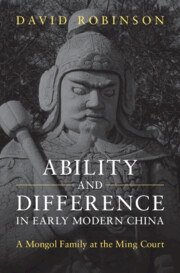
- Publisher:
- Cambridge University Press
- Online publication date:
- September 2025
- Print publication year:
- 2025
- Online ISBN:
- 9781009602006
- Subjects:
- East Asian History, Area Studies, Asian Studies, Military History, History

In 1405, a family left their home in the Mongolian steppe and moved to China. This daring decision, taken at a time of dramatic change in eastern Eurasia, paved the way for 250 years of unlikely success at the Ming court. Winning recognition for military skill and loyalty, the family later known as the Wu gained a coveted title of nobility and became members of the capital elite until the dynasty's collapse in 1644. By tracing the individual fortunes of a single family, David Robinson offers a fresh and accessible perspective on the inner workings of Ming bureaucracy. He explores how the early-modern world's most developed state sought to balance the often contradictory demands of securing ability and addressing difference, a challenge common to nearly all polities.
‘By untangling the fascinating saga of the Wu family – Mongolian migrants who rose into the Ming elite – David Robinson illuminates the overlooked military aristocracy whose diverse origins and varied skills helped Ming rule to endure for two and a half centuries. An original, carefully-textured portrait of the human face of Chinese statecraft.'
Matthew W. Mosca - University of Washington, Seattle
‘Focussing on one noble family across nine generations, this outstanding work, using superb command of the sources, offers both a fresh and important redirection of attention away from the bureaucratic portion of Ming China's elite, and an essential contribution to understanding power and status in imperial history.'
Craig Clunas - University of Oxford
‘David Robinson expands and deepens our understanding of Ming society through the story of a migrant Mongol family over two and a half centuries. The Wu family saga, and the rise to power and elite status of its members, illuminates corners of Chinese history rarely explored. The book's probing into questions such as merit, ability, and alterity brings to life the tension and contradictions of a period of Chinese history often stigmatized as xenophobic and culturally intransigent. Such a refreshing and insightful perspective deserves high praise.'
Nicola Di Cosmo - Institute for Advanced Study
 Loading metrics...
Loading metrics...
* Views captured on Cambridge Core between #date#. This data will be updated every 24 hours.
Usage data cannot currently be displayed.
This section outlines the accessibility features of this content - including support for screen readers, full keyboard navigation and high-contrast display options. This may not be relevant for you.
The PDF of this book is known to have missing or limited accessibility features. We may be reviewing its accessibility for future improvement, but final compliance is not yet assured and may be subject to legal exceptions. If you have any questions, please contact accessibility@cambridge.org.
Allows you to navigate directly to chapters, sections, or non‐text items through a linked table of contents, reducing the need for extensive scrolling.
Provides an interactive index, letting you go straight to where a term or subject appears in the text without manual searching.
You will encounter all content (including footnotes, captions, etc.) in a clear, sequential flow, making it easier to follow with assistive tools like screen readers.
You will still understand key ideas or prompts without relying solely on colour, which is especially helpful if you have colour vision deficiencies.
You gain clarity from ARIA (Accessible Rich Internet Applications) roles and attributes, as they help assistive technologies interpret how each part of the content functions.